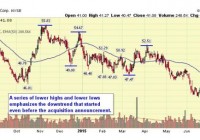Black Hills’ SourceGas Acquisition Provides Patient Investors Good Entry Point For Current Income
Summary Black Hills recently announced the acquisition of privately-owned SourceGas. The company is financing most of the acquisition by taking on additional debt. The market is punishing the company for the acquisition. The stock dropped 14% over the two weeks following the announcement. I believe the stock will decline further, but this will provide investors looking for current income a good entry point. On July 12th, Black Hills Corporation (NYSE: BKH ) announced the acquisition of SourceGas Holdings LLC from investment funds managed by Alinda Capital Partners and GE Energy Financial Services. David Butler has a nice article on the acquisition , and I’ve written previously about Black Hills Corporation’s business and dividend growth history. The acquisition increases Black Hills’ coverage in its existing service area in Colorado, Nebraska and Wyoming, and expands the company’s service area into Arkansas. The combined company’s customer base will expand by 55% to more than 1.2 million, and Black Hills claims the purchase will “meaningfully” increase earnings in the first year after closing the acquisition. Unfortunately, the company was not more specific as to how large of an earnings increase it expects. Market Sells Stock on Announcement Despite the benefits of the acquisition, the market did not react well to the news. BKH stock fell 2.4% the day after the acquisition and kept going, losing over 14% over the next two weeks. (See chart 1 below.) I believe the reaction is due to the large amount of debt that Black Hills will take on for this acquisition. While Black Hills has shown the ability to integrate acquisitions into their business, many of the past acquisitions have been less than $100 million. The SourceGas acquisition is twice as large as the $940 million acquisition of five Aquila utilities in July 2008. The bulk of the $1.89 billion cost of SourceGas will be a combination of the assumption of $720 million in SourceGas debt and an additional $450 million-$550 million in debt, which will increase Black Hills’ long-term debt by 80% to $2.76 billion. According to Bloomberg , Fitch Ratings placed Black Hills on credit watch negative due to the “material increase” in debt. Will the New Debt Impact the Dividend? I don’t expect Black Hills to stop growing its dividend. The company has increased dividends for an impressive 44 years and it isn’t likely to break this streak despite the debt burden. However, the increase in debt will limit the available funds for dividend growth. With a 55% increase in its customer base, the company should see an earnings increase from the acquisition, but will likely need to work off at least some of the new debt over time to see the full effects of the earnings growth. Over the last 5 and 10 years, Black Hills has compounded the dividend at a slow 2.4%. From 1998-2014, Black Hills increased its quarterly dividend by less than a penny a share. In 2015, the company increased the quarterly dividend by a larger-than-normal 1.5 cents. It would be difficult for the company to slow the dividend even further, but I believe that is exactly what the company will do. Until Black Hills works off the debt from this acquisition, I expect quarterly dividend growth of no more than half a cent a year. What this means for investors is that Black Hills will remain an investment for people looking for current income and not for dividend growth. Wait for BKH to Hit Support Before Buying A technical analysis of the stock movement shows that BKH was in a downtrend even before the merger announcement; the announcement only accelerated the downtrend. As shown in chart 1 below, the stock had set up a pattern of lower highs and lower lows. While the stock may currently be oversold, there is little support until $33, with stronger support at the prior consolidation around $28-$31. (See chart 2.) I think it’s likely that BKH will move to that support zone, which would give the stock a yield of 4.9%-5.2% (based on a stock price of $30-$33). I would consider selling a put or purchasing BKH outright at those levels. (click to enlarge) Chart 1: BKH was in a downtrend prior to the acquisition announcement. (click to enlarge) Chart 2: After breaking into the low $40s on heavy volume, the next major level of support is in the high $20s-low $30s. Source: Stockcharts.com The Bottom Line: The acquisition of SourceGas sets Black Hills up for future growth, but the debt overhang will limit near-term dividend growth. The market’s (over)reaction will provide investors looking for current income a good entry point as the stock moves to support. Disclosure: I/we have no positions in any stocks mentioned, but may initiate a long position in BKH over the next 72 hours. (More…) I wrote this article myself, and it expresses my own opinions. I am not receiving compensation for it (other than from Seeking Alpha). I have no business relationship with any company whose stock is mentioned in this article. Additional disclosure: As noted above, I may take a position in BKH in the near future.

